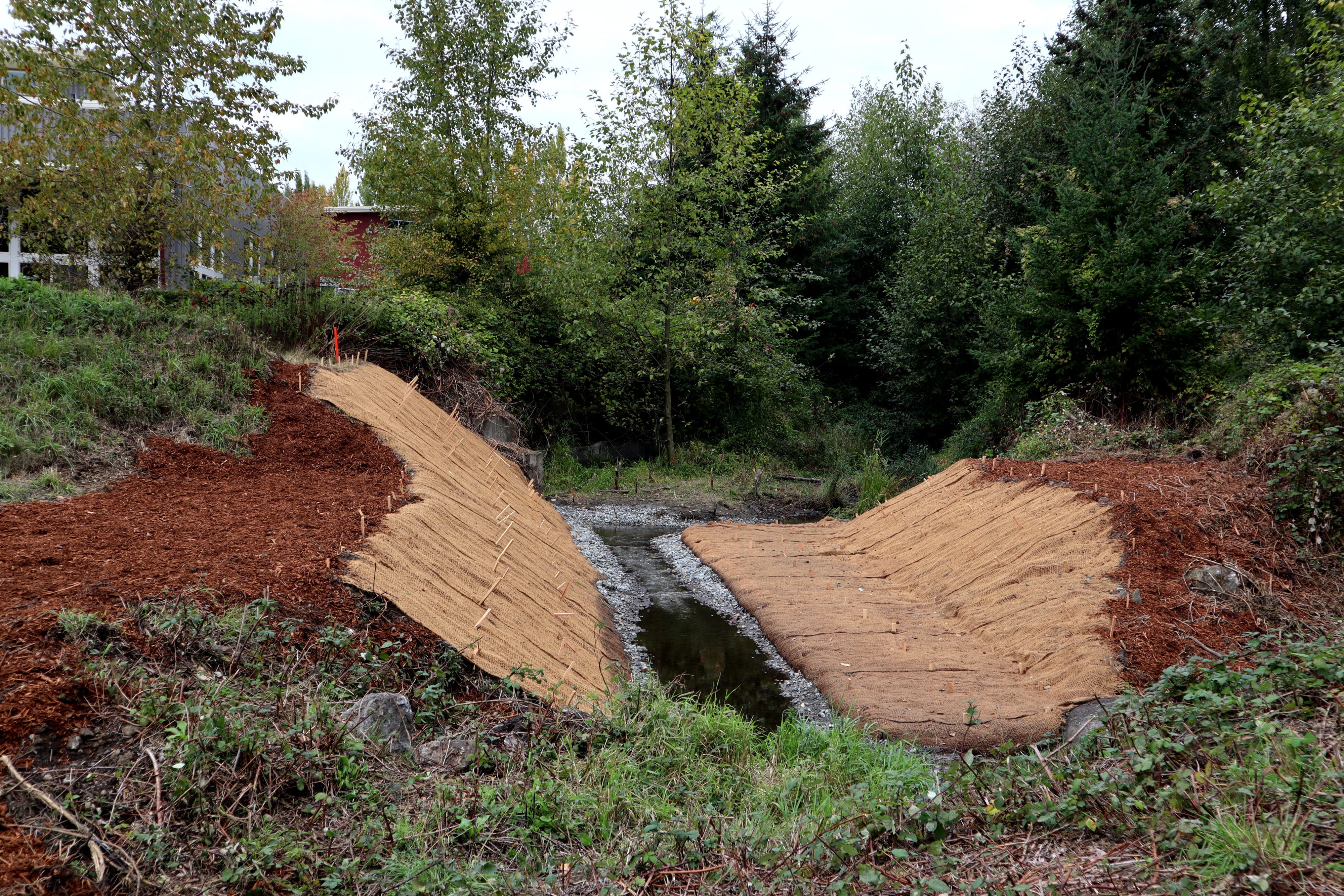Squalicum Creek is a tributary of Bellingham Bay located 2.5 miles east of the Nooksack River delta. The creek drains approximately 22 square miles, (originating in the Cascade foothills east of Bellingham and north of Lake Whatcom), and flows southeast for approximately 10 miles before discharging into Bellingham Bay. Major tributaries include Spring Creek, Baker Creek, Toad Creek, and McCormick Creek.

Squalicum Creek historically provided approximately 32 miles of accessible salmon habitat (Williams 1976). It primarily supports pink, chum, and coho salmon as well as resident and sea-run cutthroat trout. Spawner surveys and smolt traps in Squalicum Creek and its tributaries have also documented occasional use by steelhead trout. Adult Chinook and sockeye are sometimes sighted during spawner surveys, although these fish are believed to be strays from salmon runs of nearby rivers (e.g. Nooksack / Fraser), which support large populations of these species. Bull trout have not been documented in Squalicum Creek since the 1970s.
Squalicum Creek has potential to provide productive fish habitat and improved water quality within Bellingham city limits. However, the health of the ecosystem is currently impaired. Symptoms of ecosystem stress include fish passage blockages, exceedances of water quality standards, and declining salmon stocks. Water quality throughout some sections of Squalicum Creek has been found to exceed Washington State standards for several parameters including temperature, dissolved oxygen, and fecal coliform bacteria. For more information on 303(d) listings, see the Washington State Department of Ecology’s Current Water Quality Assessment Tool. Data is also available from the City’s Urban Streams Monitoring Program.
Restoration in the Squalicum Creek Watershed
Squalicum Creek Re-route Phases 1-4 Restoration Projects

The City constructed its Squalicum Creek Re-route Phases 3 and 4 project in the summer of 2020. This project reduces stream temperatures by restoring approximately 2/3 of Bug Lake – a man-made lake that causes the largest thermal-loading (i.e. heat) issues in Squalicum Creek – to forested wetland. It also includes eliminating a partial fish passage barrier under Squalicum Parkway by adding a new fish-passable culvert further south for the re-routed stream channel.
The City constructed the Squalicum Creek Re-route Phases 1 and 2 project in the summer of 2015, which involved re-routing large sections of Squalicum Creek out of Sunset Pond to improve water quality. The project re-routed large sections of the creek into a new channel, reactivated remnant channels, and reconnected the stream with its floodplain. The project also eliminated an existing fish passage blockage under I-5, opening up over 22 miles of salmon habitat upstream of I-5. You can see community photos of the project over time by visiting the Habitat Photos webpage.
Willow Spring Restoration Project

The Willow Spring project regains high-quality fish and wildlife habitat in the Squalicum Creek watershed through the construction of the Willow Spring channel and associated wetlands along the western edge of Squalicum Creek Park. Willow Spring is an off-channel habitat that provides a place for salmon to grow, feed, and rest during the long journey between Squalicum Creek and the ocean.
In 2010, the City completed the first phase of the Willow Spring project by creating approximately 1,000 lineal feet of new stream for off-channel salmon rearing habitat and refuge, nearly 1/3 of an acre of new wetlands, and nearly 1.5 acres of riparian forest. In 2018, the City was able to construct the remaining elements of the project, which included replacing an existing 12-inch culvert and artificial pond with a new open channel that connects the existing Willow Spring channel with Squalicum Creek.
Lower Squalicum Creek Restoration Project

The City of Bellingham was awarded Centennial Clean Water Fund Grants by the Department of Ecology in 2004 and 2005 to improve riparian areas along urban streams, including the Lower Squalicum Creek Restoration Project. In 2005, the City completed an extensive project to protect Squalicum Parkway from erosion, while improving fish habitat and restoring native vegetation. City-sponsored Washington Conservation Corps crews continue to clear exotic plants and weeds to ensure native vegetation becomes well established throughout the riparian area.
Additional Restoration Work
Restoration work includes multiple sites on Squalicum Creek and two of its tributaries, Baker and Spring creeks. Much of this work was completed with funding from the Centennial Clean Water Fund Grants awarded to the City by the Department of Ecology in 2004 and 2005 to improve riparian areas along urban streams, including the Lower Squalicum Creek Restoration Project. In 2005, the City completed an extensive project to protect Squalicum Parkway from erosion, while improving fish habitat and restoring native vegetation. City-sponsored Washington Conservation Corps crews have replaced invasive vegetation with native plants and installed barriers to prevent hikers from damaging sensitive riparian areas. Crews continue to maintain the sites by removing invasive vegetation to ensure native vegetation becomes well established throughout the riparian area.
Reference Documents
Resources
- Squalicum Creek Watershed Map
- City Restoration Sites Map
- Lake Whatcom Restoration Sites Map
- Washington Conservation Corps (WCC)
- Water Quality
- Habitat Restoration and Technical Assessment (HRTA)
- Fish Studies
- Habitat Restoration Projects
- City Watersheds
- Habitat Photos Community Monitoring Project
- Sign-up for Restoration Email Updates
- Squalicum Creek Re-route Phases 1-4 Restoration Projects
